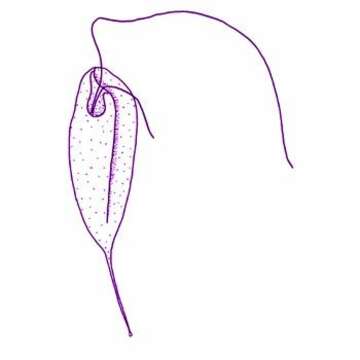Drawing

Description:
Calkinsia aureus Lackey, 1960. A euglenid, the body of which is elongately oval, narrow in cross section, enclosed in rigid pellicle, no metaboly, body 40-50 microns long, pellicle rolled inward along ventral margin, the fold being deep at the anterior end, diminishing towards the caudal spine, the mouth area beneath ventral anterior margin of pellicle, opening into a short gullet-reservoir. No contactile vacuole reported. There are two flagella, they are subequal, emerging from the floor of the reservoir, of similar diameter, neither one tapering. The shorter flagellum is directed backwards, is 25-30 microns long, the anterior flagellum is 80 microns or longer, may be suddenly retractile, then thrust sideways at an angle of 45 degrees or greater, to change the direction of progression. A looping action may be used to pull the cell forward. When the organism is still, this flagellum undulates along its distal part, appearing to have a probing function. Forward movement is slow and deliberate. The nucleus is large, in the right median plane, granular, with no visible nuclolus, no visible basal bodies or mouth in living organism, paramylon present as small discs 4-8 microns in diameter, sometimes black refringent granules resembling sulfur droplets in Beggiatoa are present, the colour is a clear or translucent, golden, no chloroplasts, the colour is in the pellicle or cytoplasm with no variation in intensity noted, pellicle faintly striated longitudinally except around ventral margin, where it becomes spiral, stigma absent, division and encystment not seen, nutrition saprozoic, anaerobic or microaerophilic.
Included On The Following Pages:
- Life (creatures)
- Cellular (cellular organisms)
- Eukaryota (eukaryotes)
- Excavates (excavates)
- Discoba (Jakobids)
- Euglenozoa
- Symbiontida
- Calkinsia
- Calkinsia aureus
This image is not featured in any collections.
Source Information
- license
- cc-by-nc
- author
- Won Je Lee
- provider
- micro*scope
- original
- original media file
- visit source
- partner site
- micro*scope
- ID


